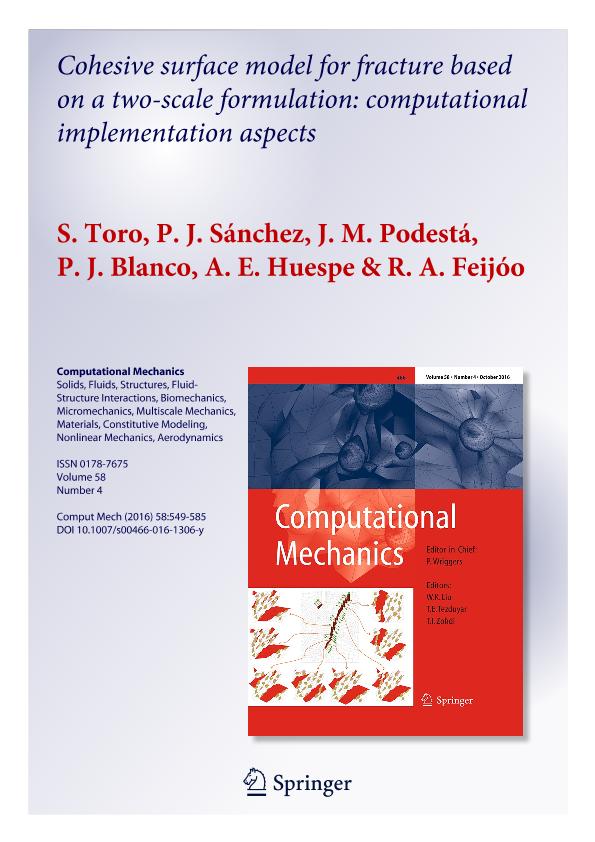Mostrar el registro sencillo del ítem
dc.contributor.author
Toro, Sebastian

dc.contributor.author
Sánchez, Pablo Javier

dc.contributor.author
Podestá, Juan Manuel

dc.contributor.author
Blanco, Pablo Javier

dc.contributor.author
Huespe, Alfredo Edmundo

dc.contributor.author
Feijóo, Raúl Antonino

dc.date.available
2019-02-20T18:52:04Z
dc.date.issued
2016-10
dc.identifier.citation
Toro, Sebastian; Sánchez, Pablo Javier; Podestá, Juan Manuel; Blanco, Pablo Javier; Huespe, Alfredo Edmundo; et al.; Cohesive surface model for fracture based on a two-scale formulation: computational implementation aspects; Springer; Computational Mechanics; 58; 4; 10-2016; 549-585
dc.identifier.issn
0178-7675
dc.identifier.uri
http://hdl.handle.net/11336/70546
dc.description.abstract
The paper describes the computational aspects and numerical implementation of a two-scale cohesive surface methodology developed for analyzing fracture in heterogeneous materials with complex micro-structures. This approach can be categorized as a semi-concurrent model using the representative volume element concept. A variational multi-scale formulation of the methodology has been previously presented by the authors. Subsequently, the formulation has been generalized and improved in two aspects: (i) cohesive surfaces have been introduced at both scales of analysis, they are modeled with a strong discontinuity kinematics (new equations describing the insertion of the macro-scale strains, into the micro-scale and the posterior homogenization procedure have been considered); (ii) the computational procedure and numerical implementation have been adapted for this formulation. The first point has been presented elsewhere, and it is summarized here. Instead, the main objective of this paper is to address a rather detailed presentation of the second point. Finite element techniques for modeling cohesive surfaces at both scales of analysis (FE2 approach) are described: (i) finite elements with embedded strong discontinuities are used for the macro-scale simulation, and (ii) continuum-type finite elements with high aspect ratios, mimicking cohesive surfaces, are adopted for simulating the failure mechanisms at the micro-scale. The methodology is validated through numerical simulation of a quasi-brittle concrete fracture problem. The proposed multi-scale model is capable of unveiling the mechanisms that lead from the material degradation phenomenon at the meso-structural level to the activation and propagation of cohesive surfaces at the structural scale.
dc.format
application/pdf
dc.language.iso
eng
dc.publisher
Springer

dc.rights
info:eu-repo/semantics/openAccess
dc.rights.uri
https://creativecommons.org/licenses/by-nc-sa/2.5/ar/
dc.subject
Computational Homogenization
dc.subject
Embedded Finite Elements (Efem)
dc.subject
Heterogeneous Material Failure
dc.subject
Multi-Scale Cohesive Models
dc.subject.classification
Ciencias de la Computación

dc.subject.classification
Ciencias de la Computación e Información

dc.subject.classification
CIENCIAS NATURALES Y EXACTAS

dc.subject.classification
Ingeniería de los Materiales

dc.subject.classification
Ingeniería de los Materiales

dc.subject.classification
INGENIERÍAS Y TECNOLOGÍAS

dc.title
Cohesive surface model for fracture based on a two-scale formulation: computational implementation aspects
dc.type
info:eu-repo/semantics/article
dc.type
info:ar-repo/semantics/artículo
dc.type
info:eu-repo/semantics/publishedVersion
dc.date.updated
2018-03-07T15:54:58Z
dc.identifier.eissn
1432-0924
dc.journal.volume
58
dc.journal.number
4
dc.journal.pagination
549-585
dc.journal.pais
Alemania

dc.journal.ciudad
Berlin
dc.description.fil
Fil: Toro, Sebastian. Consejo Nacional de Investigaciones Científicas y Técnicas. Centro Científico Tecnológico Conicet - Santa Fe. Centro de Investigaciones en Métodos Computacionales. Universidad Nacional del Litoral. Centro de Investigaciones en Métodos Computacionales; Argentina. Universidad Tecnológica Nacional; Argentina
dc.description.fil
Fil: Sánchez, Pablo Javier. Consejo Nacional de Investigaciones Científicas y Técnicas. Centro Científico Tecnológico Conicet - Santa Fe. Centro de Investigaciones en Métodos Computacionales. Universidad Nacional del Litoral. Centro de Investigaciones en Métodos Computacionales; Argentina. Universidad Tecnológica Nacional; Argentina
dc.description.fil
Fil: Podestá, Juan Manuel. Consejo Nacional de Investigaciones Científicas y Técnicas. Centro Científico Tecnológico Conicet - Santa Fe. Centro de Investigaciones en Métodos Computacionales. Universidad Nacional del Litoral. Centro de Investigaciones en Métodos Computacionales; Argentina
dc.description.fil
Fil: Blanco, Pablo Javier. Laboratorio Nacional de Computacao Cientifica; Brasil. Instituto Nacional de Ciência e Tecnologia em
Medicina Assistida por Computação Científica, Petrópolis; Brasil
dc.description.fil
Fil: Huespe, Alfredo Edmundo. Consejo Nacional de Investigaciones Científicas y Técnicas. Centro Científico Tecnológico Conicet - Santa Fe. Centro de Investigaciones en Métodos Computacionales. Universidad Nacional del Litoral. Centro de Investigaciones en Métodos Computacionales; Argentina. Centre Internacional de Métodes Numérics en Enginyeria (CIMNE), Barcelona; España
dc.description.fil
Fil: Feijóo, Raúl Antonino. Laboratorio Nacional de Computacao Cientifica; Brasil. Instituto Nacional de Ciência e Tecnologia em
Medicina Assistida por Computação Científica, Petrópolis; Brasil
dc.journal.title
Computational Mechanics

dc.relation.alternativeid
info:eu-repo/semantics/altIdentifier/doi/http://dx.doi.org/10.1007/s00466-016-1306-y
dc.relation.alternativeid
info:eu-repo/semantics/altIdentifier/url/https://link.springer.com/article/10.1007%2Fs00466-016-1306-y
Archivos asociados
